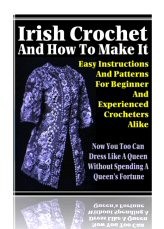 License Type: Resell Rights
License Type: Resell Rights  File Size: 6,193 KB
File Size: 6,193 KB File Type: ZIP
File Type: ZIP
 SKU: 17197
SKU: 17197  Shipping: Online Download
Shipping: Online Download
Ebook Sample Content Preview:
Figure 57A - This filling is a very favorite one in Irish crochet. It is composed of chainstitch bars with picots. To learn it, baste a piece of braid or a ch of sts upon a piece of foundation in the form of a square. Join the cotton with a d c to the righthand corner of square. * Work 5 ch, 1 d c in the 4th st from needle, ch 7, 1 d c in the 4th st from needle, ch 2; this makes a complete picot bar. Lay this bar along the lower edge to the left, and, using it as a measure, observe where the center between the 2 p comes; work 1 d c into the ch or braid at that point, repeat from * along the lower edge of the square. In the model the row ends with a half bar thus: ch 5, 1 d c into the 4th st from hook, ch 1, take the half bar across the corner and work 1 d c in the left-hand edge. Work a p bar as before; 1 d c over the chain between the 2 p of last bar in the 1st row, repeat the whole way across, ending with a half bar. Continue row upon row of these picot bars until the space is filled, taking care to make the joinings to the edges of the square, so as not to interfere with the evenness of the diagonal lines of the filling. Practice this filling, first in square spaces, and then in irregularly shaped ones, until you can fill them up evenly and easily before attempting to fill in the lace. Like all fillings, the worker must adapt it as she proceeds to the particular shape of each space to be filled. In filling a piece of lace the easiest point from which to start the filling is near the end of an angle or a narrow space.
Figure 57B - Join the thread one-fourth inch from the bottom of narrow space, * ch 5, join the last 4 sts in a p by working a d c in the 2nd st of ch, ch 1, 1 d c in the other side of space about one-fourth inch higher up than the 1st d c; * repeat from * making t c instead of d c as the space widens.
Figure 57C - This filling is a regular filling having but one picot to a loop, and is made as follows: ch 5, 1 d c in the 2nd ch, ch 4, miss a space half the length of a loop and catch with a d c; repeat, working the second row into the first.
Figure 57D - This filling is a chain and knot background; for directions for working the knot see "Explanation of Stitches". This knot is not as much used as the chain and picot for background, as it is harder to make, but as it makes a very beautiful background it is well worth practicing to acquire the art of making it successfully. Chain 5, make a knot on the 5 ch, ch 4, miss a space half the length of the chain and catch with a d c; repeat as required, working the 2nd row into the 1st.
Figure 57E - This filling is a variation of that at C. The bars are made in the same way, but are not placed in the same orderly manner, with diagonal lines, but are worked irregularly, d t c, t c, d c and sl sts are used as necessary in catching the chains. Many workers prefer the irregular filling, finding it easier to work; it is very largely used. There is a general principle which should be observed in all fillings; that is, to make the holes between the bars as uniform in size as possible, even when, as in this filling, they must be varied in shape. Nothing looks worse than to see one portion openly filled, and another closely filled in the same piece of lace.








